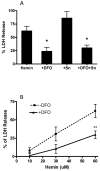Hemin uptake and release by neurons and glia
- PMID: 24164169
- PMCID: PMC3891506
- DOI: 10.3109/10715762.2013.859386
Hemin uptake and release by neurons and glia
Abstract
Hemin accumulates in intracerebral hematomas and may contribute to cell injury in adjacent tissue. Despite its relevance to hemorrhagic CNS insults, very little is known about hemin trafficking by neural cells. In the present study, hemin uptake and release were quantified in primary murine cortical cultures, and the effect of the hemin-binding compound deferoxamine (DFO) was assessed. Net uptake of (55)Fe-hemin was similar in mixed neuron-glia, neuron, and glia cultures, but was 2.6-3.6-fold greater in microglia cultures. After washout, 40-60% of the isotope signal was released by mixed neuron-glia cultures into albumin-containing medium within 24 h. Inhibiting hemin breakdown with tin protoporphyrin IX (SnPPIX) had minimal effect, while release of the fluorescent hemin analog zinc mesoporphyrin was quantitatively similar to that of (55)Fe-hemin. Isotope was released most rapidly by neurons (52.2 ± 7.2% at 2 h), compared with glia (15.6 ± 1.3%) and microglia (17.6 ± 0.54%). DFO did not alter (55)Fe-hemin uptake, but significantly increased its release. Mixed cultures treated with 10 μM hemin for 24 h sustained widespread neuronal loss that was attenuated by DFO. Concomitant treatment with SnPPIX had no effect on either enhancement of isotope release by DFO or neuroprotection. These results suggest that in the presence of a physiologic albumin concentration, hemin uptake by neural cells is followed by considerable extracellular release. Enhancement of this release by DFO may contribute to its protective effect against hemin toxicity.
Conflict of interest statement
Declaration of Interest
This study was supported by a grant from the National Institutes of Health (NS079500) to R.F.R. The authors have no financial or consulting interests which could influence this work.
Figures




References
-
- Letarte PB, Lieberman K, Nagatani K, Haworth RA, Odell GB, Duff TA. Hemin: levels in experimental subarachnoid hematoma and effects on dissociated vascular smooth muscle cells. J Neurosurg. 1993;79(2):252–255. - PubMed
-
- Robinson SR, Dang TN, Dringen R, Bishop GM. Hemin toxicity: a preventable source of brain damage following hemorrhagic stroke. Redox Rep. 2009;14(6):228–35. - PubMed
Publication types
MeSH terms
Substances
Grants and funding
LinkOut - more resources
Full Text Sources
Other Literature Sources
